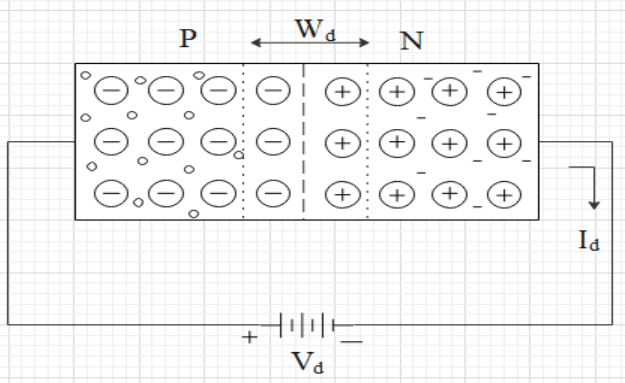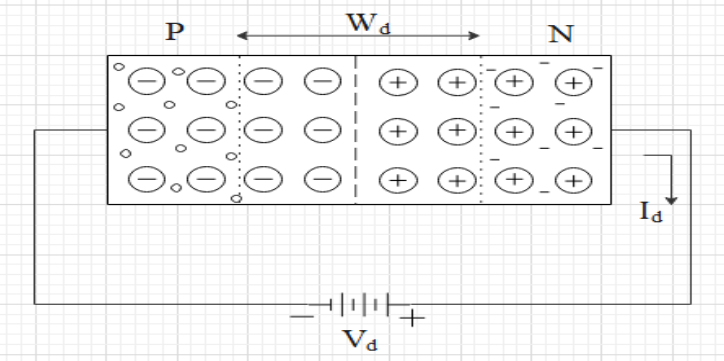
What is meant by forwarding bias and reverse bias of the diode? Indicate in a figure.
Answer
496.8k+ views
Hint: In semiconductors doping with acceptor impurities or doping with donor impurities makes the semiconductors more efficient. Both forward bias and reverse bias are the special cases of the P-N junction diode. The joining of the terminals of voltage source with P-type or N-type makes different biases like forward and reverse biases.
Complete step-by-step solution:
Forward bias: If the positive of the voltage terminal joined with the P section is called forward bias.

In the forward bias condition the positive voltage is joining with P-type so the positively charged holes repulse towards the depletion layer (
Reverse bias: If the positive of the voltage terminal joined with the N section is called reverse bias.

In reverse bias condition, there is an attraction between holes of P-type with negative terminal and the electrons of N-type with a positive terminal. So near the depletion layer the immobile ions are uncovered with holes and electrons, this leads to increases in the depletion layer and increases in potential barrier also. So the majority charge carrier in P-type cannot overcome the potential barrier and electrons also cannot overcome the potential barrier. There is only saturation current that is flowing which is very small (order of
Additional Information: There are three possibilities of bias-no bias, forward bias, and reverse bias. Bias means when P-type and N-type join together and the external voltage applied to it is called bias. No bias can say without external voltage or just after the making of the diode. In a semiconductor diode, in the P-type there are holes are majority charge carrier and electrons are minority charge carrier and in N-type, there are electrons are the majority charge carrier and the holes are minority charge carrier.
Note:
(1) In forward bias, the increase in bias potential, the width of the depletion region decrease and the barrier potential also reduces.
(2) In reverse bias, the increase in bias potential, the width of the depletion region increases and the barrier potential also increases.
(3)
Complete step-by-step solution:
Forward bias: If the positive of the voltage terminal joined with the P section is called forward bias.

In the forward bias condition the positive voltage is joining with P-type so the positively charged holes repulse towards the depletion layer (
Reverse bias: If the positive of the voltage terminal joined with the N section is called reverse bias.

In reverse bias condition, there is an attraction between holes of P-type with negative terminal and the electrons of N-type with a positive terminal. So near the depletion layer the immobile ions are uncovered with holes and electrons, this leads to increases in the depletion layer and increases in potential barrier also. So the majority charge carrier in P-type cannot overcome the potential barrier and electrons also cannot overcome the potential barrier. There is only saturation current that is flowing which is very small (order of
Additional Information: There are three possibilities of bias-no bias, forward bias, and reverse bias. Bias means when P-type and N-type join together and the external voltage applied to it is called bias. No bias can say without external voltage or just after the making of the diode. In a semiconductor diode, in the P-type there are holes are majority charge carrier and electrons are minority charge carrier and in N-type, there are electrons are the majority charge carrier and the holes are minority charge carrier.
Note:
(1) In forward bias, the increase in bias potential, the width of the depletion region decrease and the barrier potential also reduces.
(2) In reverse bias, the increase in bias potential, the width of the depletion region increases and the barrier potential also increases.
(3)
Latest Vedantu courses for you
Grade 10 | CBSE | SCHOOL | English
Vedantu 10 CBSE Pro Course - (2025-26)
School Full course for CBSE students
₹35,000 per year
Recently Updated Pages
Express the following as a fraction and simplify a class 7 maths CBSE

The length and width of a rectangle are in ratio of class 7 maths CBSE

The ratio of the income to the expenditure of a family class 7 maths CBSE

How do you write 025 million in scientific notatio class 7 maths CBSE

How do you convert 295 meters per second to kilometers class 7 maths CBSE

Write the following in Roman numerals 25819 class 7 maths CBSE

Trending doubts
Give 10 examples of unisexual and bisexual flowers

Draw a labelled sketch of the human eye class 12 physics CBSE

Differentiate between homogeneous and heterogeneous class 12 chemistry CBSE

Differentiate between insitu conservation and exsitu class 12 biology CBSE

What are the major means of transport Explain each class 12 social science CBSE

Franz thinks Will they make them sing in German even class 12 english CBSE




